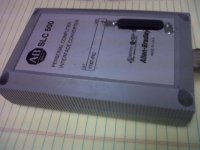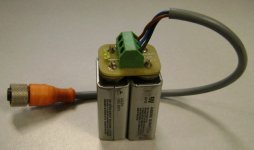You are using an out of date browser. It may not display this or other websites correctly.
You should upgrade or use an alternative browser.
You should upgrade or use an alternative browser.
What have you built?
- Thread starter shawn_75
- Start date
kittydog42
Member
I made two panel benches out of steel. Each is about waist high so that an upright panel will be at the right height for working on either standing up or sittng on a stool. There are two sides each about 1' x 4' for storing tools or parts, and a shelf underneath for larger spools of wire. The table top itself is two pieces of strut with a front hinge that the back panel bolts to. After drilling and tapping, it hinged up and adjustable pieces of chain hold the panel at the desired angle. Across the top overhead is a pipe used to hold spools of wire. In front is a tray used to hold hand tools like screwdrivers, etc. We have been using them for eight years or so. I can't even imaging going back to the cobbed-together wooden panel tables that we used to use.
TomekPLC
Member
The Plc Kid
Member
When ribbon cable started causing issues on my pic box (1747-PIC) I installed D25 connector inside of the box.
Tom
Awesome. Those ribbon cables seemed to always get damaged no matter how hard you tried to prevent it.
Clay B.
Lifetime Supporting Member
OT: because I did not build them but I picked up a pair of these boys in lowes the other day and man are they handy.
http://www.channellock.com/locknut.aspx
I got a set of these out of a German tool box that came with a machine. The mechinics on site had no idea what they were so they just gave them to me. That was about 10 years ago aand I have used them so much the padding on one of the handles is about to fall off.
I did not know channellock made them now( need to make a trip to Lowes)
Clay B.
Lifetime Supporting Member
Made a "solenoid" test tool for the maintenace guys at the last place I worked.
It was a reed switch from a door interlock attached to some batteries and a LED.
Because a solenoid would generate a magnetic field whenever it was on the mainteance guys could just touch the solenoid coil with the sensor head and see if the solenoid was on.
I built it so the sensor head was on one end and the LED was on the other with 3 AAA bateries in the middle.. Basically it looked like a long marker so the guys would carry them in their pocket.
It was a reed switch from a door interlock attached to some batteries and a LED.
Because a solenoid would generate a magnetic field whenever it was on the mainteance guys could just touch the solenoid coil with the sensor head and see if the solenoid was on.
I built it so the sensor head was on one end and the LED was on the other with 3 AAA bateries in the middle.. Basically it looked like a long marker so the guys would carry them in their pocket.
Gil47
Member
When I work on D shell plugs I find a third or forth hand would be useful
I got the magnet out of an old loudspeaker, the bigger, heavier, the better and use it to hold the D shell at a multitude of angles so I can for example solder terminals.
That third hand is alot steadier than the other two
I got the magnet out of an old loudspeaker, the bigger, heavier, the better and use it to hold the D shell at a multitude of angles so I can for example solder terminals.
That third hand is alot steadier than the other two
Ned_Flanders
Member
Mains tester
I made a mains tester 20 years ago after a friend dropped his. I couldn't believe all it consisted of was two neons and a 1Mohm resistor.
Yes, you can buy them - for only a few £'s - but this cost NOTHING!

I made a mains tester 20 years ago after a friend dropped his. I couldn't believe all it consisted of was two neons and a 1Mohm resistor.
Yes, you can buy them - for only a few £'s - but this cost NOTHING!

Last edited:
Ned_Flanders
Member
LOL "Red" = on."Light red" = Dimly on - fault, like no earth when both neons are lit dimly.Markie,
It appears as if your N and L are reversed.
Is that the label plate from the one that was dropped?
Shawn
I made the label plate as my employer had an engraver - but no orange/white material!
Last edited:
I made a short-circuit tester from a blown fuse and a pilot light. The fuse was mounted to the back of the pilot light and I soldered wires on the ends of the fuse and wired them to the pilot light. Snap it in to the fuseholder with the short circuit and the light will stay on while you isolate the branch with the fault (in some cases there would be 30-40 branches on the same circuit).
Very handy, so handy in fact that one of the maintenance guys stole it from me.
I've also done the current source circuit with a resistor bank to switch between 4, 8, 12, 16, and 20ma.
The locknut pliers look like a neat thing!
Very handy, so handy in fact that one of the maintenance guys stole it from me.
I've also done the current source circuit with a resistor bank to switch between 4, 8, 12, 16, and 20ma.
The locknut pliers look like a neat thing!
Kev77
Member
I made a short-circuit tester from a blown fuse and a pilot light. The fuse was mounted to the back of the pilot light and I soldered wires on the ends of the fuse and wired them to the pilot light. Snap it in to the fuseholder with the short circuit and the light will stay on while you isolate the branch with the fault (in some cases there would be 30-40 branches on the same circuit).
I've got one of them! Well, its a little different...
It is a jumper wire that I stick in the socket and watch the arc! I call it the "THUMPER". Sometimes you need to replace the receptacle due to melted plastic... Just kidding
I have used lights on circuits in the past that would keep blowing fuses. It allows the fuse to hold until you can track down the source of the fault. You just need to be careful.
kolyur
Lifetime Supporting Member + Moderator
brucechase
Member
Hydro Power Guy
Member
Similar Topics
Dear all,
what type of built in port does fx2n-80mr plc has? i mean is it rs232, r rs422 or rs485. and which module should i use to convert to...
- Replies
- 5
- Views
- 117
Does anyone have any recommendations for Electronic Circuit Breakers with 0V Terminals built-in and Fieldbus (IO-LINK, MODBUS TCP, EtherNet/IP?)...
- Replies
- 2
- Views
- 192
My PLC (S7-1200) and HMI (KTP-1200 Basic) has been delivered on-site to the customer.
To be able to do "off-line" updates to the code, I am using...
- Replies
- 4
- Views
- 223
I am wondering if anyone has seen an input IO block that has a built in AND function for the inputs and the output of the block is a normal M12 5...
- Replies
- 13
- Views
- 885
Hi,
My PLC hardware has been delivered to customer site - many thanks for the invaluable help on this forum!
I was looking into see if it's...
- Replies
- 12
- Views
- 2,509









